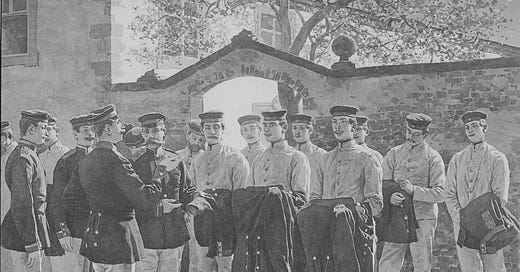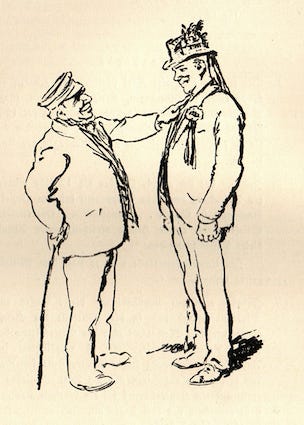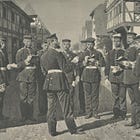From time to time, The Tactical Notebook will republish a post from our back catalog. (This often happens when the revived article provides background to a new piece.)
A reader cannot spend much time with the literature about the German armies of the First World War without running into the word Ersatz. Indeed, locating examples of the use of this ubiquitous word is far easier than coming up with a workable translation.
The heart of the problem lies in the use of the word Ersatz is to describe a whole range of phenomena. Though there is no evidence that such a passage actually exists, it is possible to imagine a paragraph in a German regimental history or military biography in which an Ersatzreservist leaves his Ersatzbataillon in the company of other Ersatzmannschaften in an Ersatztransport headed for a Brigade-Ersatz-Bataillon belonging to an Ersatz-Brigade. Throughout this journey, our hero takes periodic breaks to imbibe some Ersatzkaffee.
From a purely linguistic point of view, the word Ersatz is a simple one. Derived from the verb ersetzen - meaning “to replace” - Ersatz can often be translated as “replacement.” Thus, for example, Ersatzkaffee was not coffee at all. Rather, it was a substitute for coffee made from things, like acorns and chicory, other than coffee beans. Similarly, Ersatzmannschaften were soldiers sent to a unit on active service to replace men who had become casualties. Similarly, an Ersatztransport was a group of such men traveling together.
An Ersatzbataillon was the home of the Ersatzmannschaften before they left for the front. Established by each infantry regiment at its home garrison in Germany, each Ersatzbataillon consisted of two elements: a recruit depot for the basic training of men with no prior service and a holding unit for men who had completed such training, as well as those who were recovering from wounds or serious sickness. (The Ersatz units other than those of infantry regiments bore titles appropriate their arm of service. Thus, the Ersatz unit of a cavalry regiment was known as an “Ersatz squadron.”)
An Ersatzreservist was a man who, in the long years leading up to 1914, had avoided most, if not all, peacetime military training. One reason for such an exemption was a slight defect of health. Another was responsibility for the support of a family. The third, and, at times, most common reason, was the lack of space in the ranks. Indeed, in the decade leading up to 1914, only about half of the young men eligible for military service were “called to the colors.” The remainder were examined, classified, and sent directly to the Ersatzreserve.
To further confuse matters, the German armies also applied the term Ersatz to a category of second-line units destined for active service in the field. All such units, whether infantry battalions, artillery batteries, or cavalry squadron, were distinguished from the training and holding units at home by the addition of the moniker of mobile to the descriptor of Ersatz.
A mobile Ersatz infantry battalion was also known as a Brigade-Ersatz-Battalion. This reminded all concerned of two definitive features of such a unit. The first was the fact that the members of a given Brigade-Ersatz-Battalion came from the training and holding battalions of the two component regiments of a single peacetime infantry brigade. The second was the practice of combining such battalions, along with mobile Ersatz field artillery batteries and cavalry squadrons, into small all-arms formations called “mixed Ersatz brigades” (gemischte Ersatz-Brigaden).
The men of mobile Ersatz units were, as a rule, members of either the Reserve or the Landwehr. (Soldiers of the first category, known as Reservisten, were veterans of two or more years of peacetime service who were younger than 27 years of age. Men of the second category, known as Landwehrmänner, had also served for two or more years with the colors, but were older than Reservisten by as much as twelve years.)
Marvelous to say, the second-line soldier least likely to find himself in a mobile Ersatz unit at the start of the war was the Ersatzreservist. Rather, because they had yet to be properly trained, Ersatzreservisten were, upon mobilization, either sent to recruit depots or returned to their homes to await call up at some subsequent point in time.
The great exception to this general rule took place in the eastern provinces of the German Empire during the Russian invasion of East Prussia. In response to that crisis, the training and holding units formed in the course of mobilization were employed for operational purposes. As might be expected, the leaders commanding German formations tried to provide these untrained units with assignments appropriate to their capabilities. There were, however, instances of such units fighting alongside active, Reserve, and Landwehr units, as well as mobile Ersatz battalions, batteries, and squadrons.
Source: Karl Deuringer, Die Schlacht in Lothringen und in den Vogesen 1914, Die Feuertaufe der Bayerischen Armee (Munich: M. Schick, 1929) pages 1-32
For Further Reading:
To Share, Subscribe, or Support:








